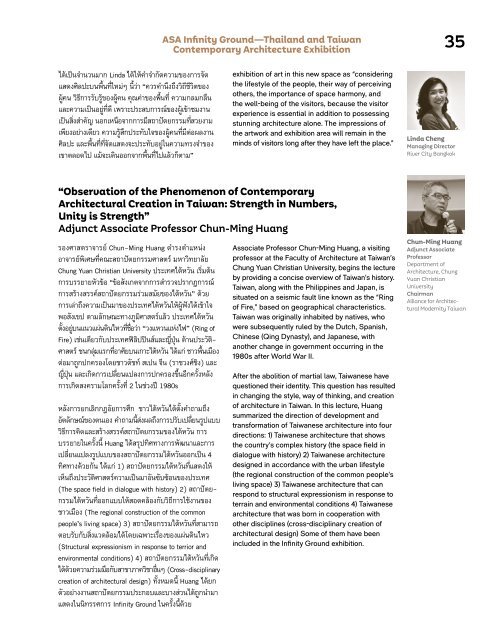ASA JOURNAL 14/2023
Create successful ePaper yourself
Turn your PDF publications into a flip-book with our unique Google optimized e-Paper software.
<strong>ASA</strong> Infinity Ground—Thailand and Taiwan<br />
Contemporary Architecture Exhibition<br />
35<br />
ได้เป็นจำานวนมาก Linda ได้ให้คำาจำากัดความของการจัด<br />
แสดงศิลปะบนพื้นที่ใหม่ๆ นี้ว่า “ควรคำ านึงถึงวิถีชีวิตของ<br />
ผู้คน วิธีการรับรู้ของผู้คน คุณค่าของพื้นที่ ความกลมกลืน<br />
และความเป็นอยู่ที่ดี เพราะประสบการณ์ของผู้เข้าชมงาน<br />
เป็นสิ่งสำาคัญ นอกเหนือจากการมีสถาปัตยกรรมที่สวยงาม<br />
เพียงอย่างเดียว ความรู้สึกประทับใจของผู้คนที่มีต่อผลงาน<br />
ศิลปะ และพื้นที่ที่จัดแสดงจะประทับอยู่ในความทรงจำ าของ<br />
เขาตลอดไป แม้จะเดินออกจากพื้นที่ไปแล้วก็ตาม”<br />
exhibition of art in this new space as “considering<br />
the lifestyle of the people, their way of perceiving<br />
others, the importance of space harmony, and<br />
the well-being of the visitors, because the visitor<br />
experience is essential in addition to possessing<br />
stunning architecture alone. The impressions of<br />
the artwork and exhibition area will remain in the<br />
minds of visitors long after they have left the place.”<br />
Linda Cheng<br />
Managing Director<br />
River City Bangkok<br />
“Observation of the Phenomenon of Contemporary<br />
Architectural Creation in Taiwan: Strength in Numbers,<br />
Unity is Strength”<br />
Adjunct Associate Professor Chun-Ming Huang<br />
รองศาสตราจารย์ Chun-Ming Huang ดำารงตำาแหน่ง<br />
อาจารย์พิเศษที่คณะสถาปัตยกรรมศาสตร์ มหาวิทยาลัย<br />
Chung Yuan Christian University ประเทศไต้หวัน เริ่มต้น<br />
การบรรยายหัวข้อ “ข้อสังเกตจากการสำารวจปรากฎการณ์<br />
การสร้างสรรค์สถาปัตยกรรมร่วมสมัยของไต้หวัน” ด้วย<br />
การเล่าถึงความเป็นมาของประเทศไต้หวันให้ผู้ฟังได้เข้าใจ<br />
พอสังเขป ตามลักษณะทางภูมิศาสตร์แล้ว ประเทศไต้หวัน<br />
ตั้งอยู่บนแนวแผ่นดินไหวที่ชื่อว่า “วงแหวนแห่งไฟ” (Ring of<br />
Fire) เช่นเดียวกับประเทศฟิลิปปินส์และญี่ปุ่น ด้านประวัติ-<br />
ศาสตร์ ชนกลุ่มแรกที่อาศัยบนเกาะไต้หวัน ได้แก่ ชาวพื้นเมือง<br />
ต่อมาถูกปกครองโดยชาวดัชท์ สเปน จีน (ราชวงศ์ชิง) และ<br />
ญี่ปุ่น และเกิดการเปลี่ยนแปลงการปกครองขึ้นอีกครั้งหลัง<br />
การเกิดสงครามโลกครั้งที่ 2 ในช่วงปี 1980s<br />
หลังการยกเลิกกฎอัยการศึก ชาวไต้หวันได้ตั้งคำ าถามถึง<br />
อัตลักษณ์ของตนเอง คำาถามนี้ส่งผลถึงการปรับเปลี่ยนรูปแบบ<br />
วิธีการคิดและสร้างสรรค์สถาปัตยกรรมของไต้หวัน การ<br />
บรรยายในครั้งนี้ Huang ได้สรุปทิศทางการพัฒนาและการ<br />
เปลี่ยนแปลงรูปแบบของสถาปัตยกรรมไต้หวันออกเป็น 4<br />
ทิศทางด้วยกัน ได้แก่ 1) สถาปัตยกรรมไต้หวันที่แสดงให้<br />
เห็นถึงประวัติศาสตร์ความเป็นมาอันซับซ้อนของประเทศ<br />
(The space field in dialogue with history) 2) สถาปัตย-<br />
กรรมไต้หวันที่ออกแบบให้สอดคล้องกับวิถีการใช้งานของ<br />
ชาวเมือง (The regional construction of the common<br />
people’s living space) 3) สถาปัตยกรรมไต้หวันที่สามารถ<br />
ตอบรับกับสิ่งแวดล้อมได้โดยเฉพาะเรื่องของแผ่นดินไหว<br />
(Structural expressionism in response to terrior and<br />
environmental conditions) 4) สถาปัตยกรรมไต้หวันที่เกิด<br />
ได้ด้วยความร่วมมือกับสาขาภาควิชาอื่นๆ (Cross-disciplinary<br />
creation of architectural design) ทั้งหมดนี้ Huang ได้ยก<br />
ตัวอย่างงานสถาปัตยกรรมประกอบและบางส่วนได้ถูกนำามา<br />
แสดงในนิทรรศการ Infinity Ground ในครั้งนี้ด้วย<br />
Associate Professor Chun-Ming Huang, a visiting<br />
professor at the Faculty of Architecture at Taiwan’s<br />
Chung Yuan Christian University, begins the lecture<br />
by providing a concise overview of Taiwan’s history.<br />
Taiwan, along with the Philippines and Japan, is<br />
situated on a seismic fault line known as the “Ring<br />
of Fire,” based on geographical characteristics.<br />
Taiwan was originally inhabited by natives, who<br />
were subsequently ruled by the Dutch, Spanish,<br />
Chinese (Qing Dynasty), and Japanese, with<br />
another change in government occurring in the<br />
1980s after World War II.<br />
After the abolition of martial law, Taiwanese have<br />
questioned their identity. This question has resulted<br />
in changing the style, way of thinking, and creation<br />
of architecture in Taiwan. In this lecture, Huang<br />
summarized the direction of development and<br />
transformation of Taiwanese architecture into four<br />
directions: 1) Taiwanese architecture that shows<br />
the country’s complex history (the space field in<br />
dialogue with history) 2) Taiwanese architecture<br />
designed in accordance with the urban lifestyle<br />
(the regional construction of the common people’s<br />
living space) 3) Taiwanese architecture that can<br />
respond to structural expressionism in response to<br />
terrain and environmental conditions 4) Taiwanese<br />
architecture that was born in cooperation with<br />
other disciplines (cross-disciplinary creation of<br />
architectural design) Some of them have been<br />
included in the Infinity Ground exhibition.<br />
Chun-Ming Huang<br />
Adjunct Associate<br />
Professor<br />
Department of<br />
Architecture, Chung<br />
Yuan Christian<br />
University<br />
Chairman<br />
Alliance for Architectural<br />
Modernity Taiwan


















